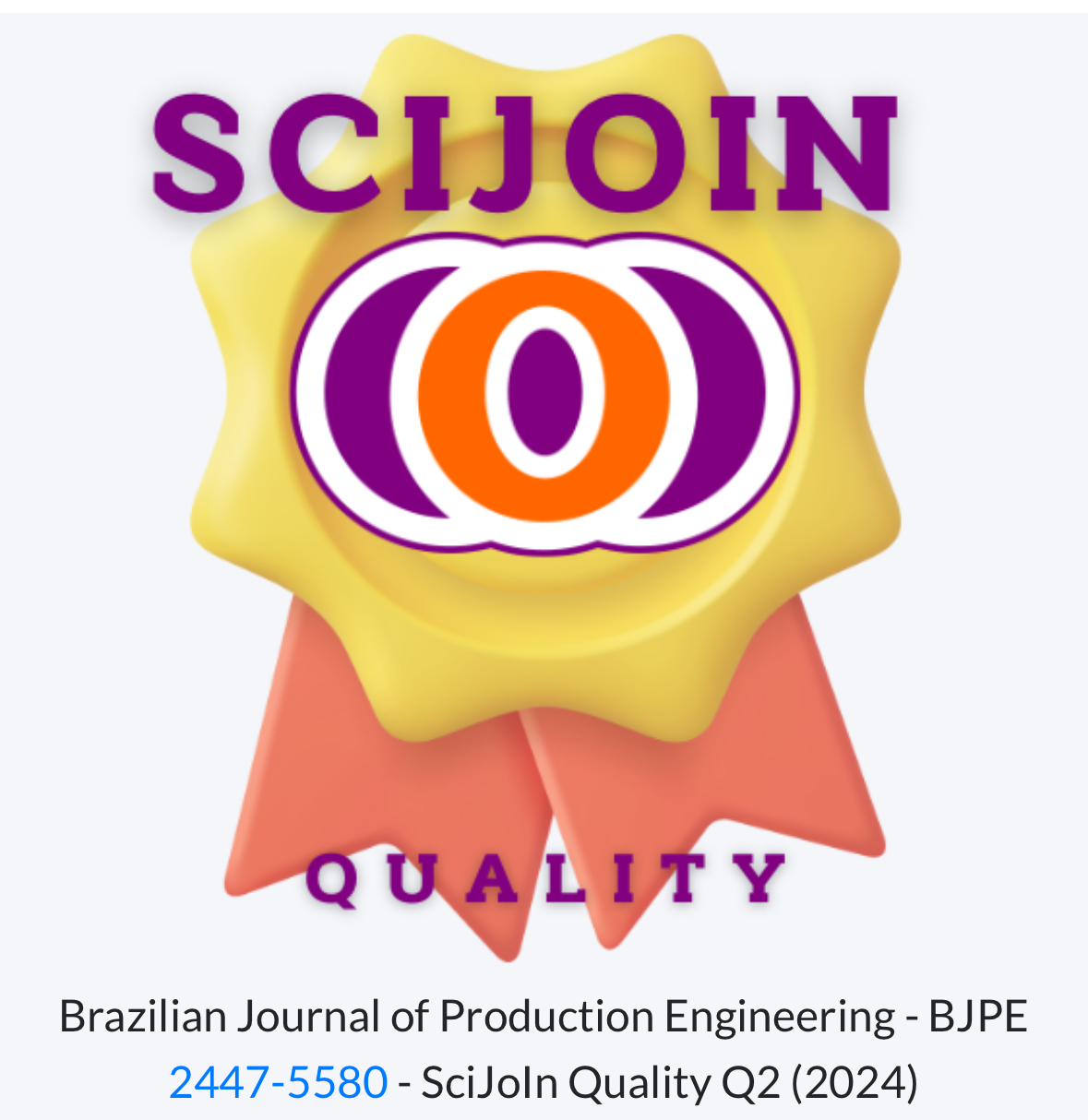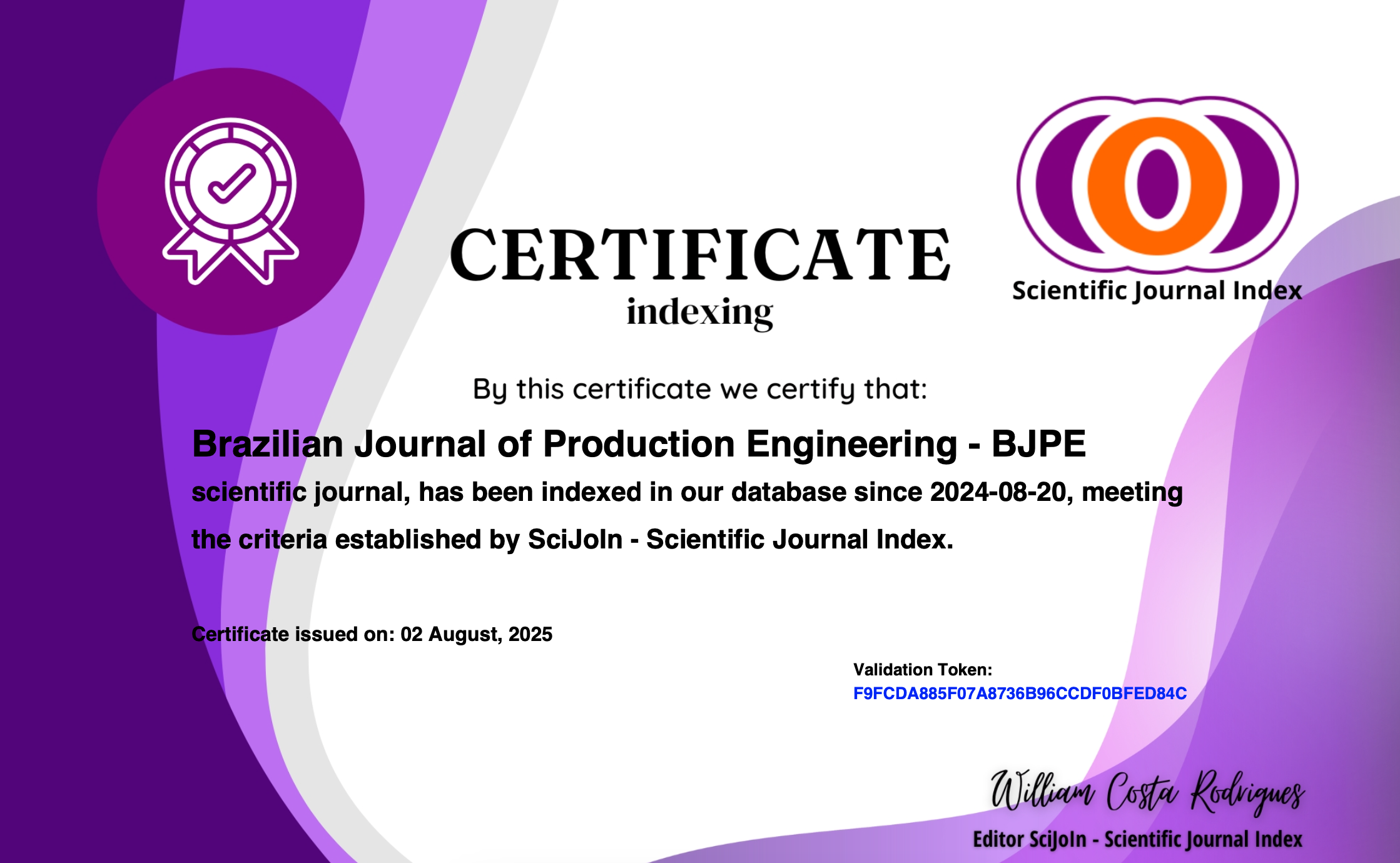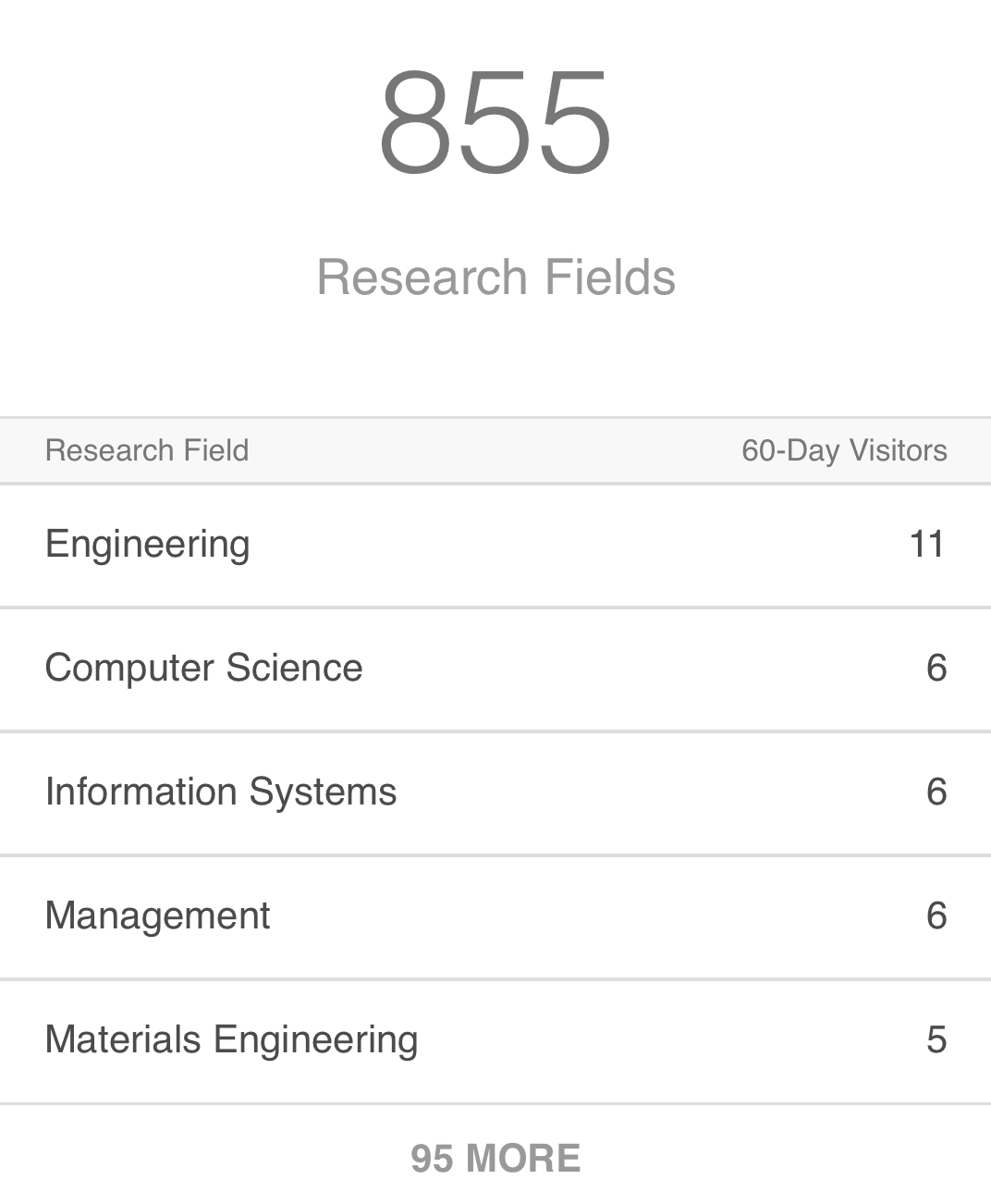COMPETÊNCIAS OPERACIONAIS PARA ALCANÇAR VANTAGENS COMPETITIVAS: ESTRATÉGIAS DE EXPLORAÇÃO DE RECURSOS INTERORGANIZACIONAIS
Resumo
*Autor Correspondente: Rodrigo Randow de Freitas.
RESUMO
Discutem-se aqui as relações entre empresas, diante da integração de diversas perspectivas do campo dos recursos internos e relacionais, competências operacionais e relacionamento colaborativo, com o objetivo de analisar recursos relacionais influenciadores no desenvolvimento de competências operacionais. A investigação foi orientada pela estratégia de estudo de casos múltiplos no setor siderúrgico, aplicações automotivas e industriais,
produção de celulose e engenharia para a indústria
energética. Resultados apontam que a decisão pelo compartilhamento de recursos é rara e inimitável e está relacionada ao desenvolvimento de vantagens competitivas entre empresas.Essas competências representam a capacidade da empresa de promover um conjunto de habilidades para usar eficientemente os recursos, promover uma barreira à imitação e são desenvolvidas mais intensamente pelos construtos informação e conhecimento.
ABSTRACT
We discuss the relations between companies, in view of the integration of diverse perspectives from the field of internal and relational resources, operational skills and collaborative relationship, with the objective of analyzing relational resources influencing the development of operational competencies. The research was guided by the strategy of multiple case studies in the steel industry, automotive and industrial applications, pulp production and engineering for the energy industry. Results show that the decision to share resources is rare and inimitable and is related to the development of competitive advantages between companies. These competencies represent the company's ability to promote a set of skills to efficiently use resources, promote a barrier to imitation, and are developed more intensively by information and knowledge constructs.
Downloads
Referências
Amit, R. & Schoemaker, P. J. H. (1993). Strategic assets and organizational rent.Strategic Management Journal, 14(1), 33-46.
Asanuma, B. (1989). Manufacturer-Supplier Relationships in Japan and the Concept of Relationship-Specific Skill. Journal of the Japanese and International Economies, 3(1), 1-30.doi: 10.1016/0889-1583(89)90029-4
Balestrin, A.,Verschoore, J. R. & Perucia, A. (2014). The relational view of strategy: Empirical evidence from business cooperation networks. Revista de Administração e Contabilidade de Unisinos. 11(1), 47-58.
Bardin, L. (2011). Análise de conteúdo. São Paulo: Edições 70.
Barney, J. B. (1991). Firm resources and sustained competitive advantage. Journal of Management, 17(1), 99-120.
Barney, J. B. &Clark, D. N. (2007). Resource-Based Theory: Creating and Sustaining Competitive Advantage. Nova York: Oxford University Press.
Barney, J. B. & Hesterly, W. S. (2011). Administração Estratégica e Vantagem Competitiva (3a ed.). São Paulo: Pearson Prentice Hall.
Barney, J. B., KetchenJr., D. J. & Writht, M. (2011). The Future of Resource-Based Theory: Revitalization or Decline? Journal of Management, 37(5), 1299-1315.doi: 10.1177/0149206310391805
Bowersox, D. J. & Closs, D. J. (2001).Logística Empresarial: O Processo de Integração da Cadeia de Suprimento. São Paulo: Atlas.
Burgess, K.,Singh, P. J. & Koroglu, R. (2006). Supply chain management: a structured literature review and implications for future research. International Journal of Operations; Production Management, 26(7), 703-729. doi: 10.1108/01443570610672202
Cao, M. &Zhang, Q. (2011). Supply Chain Collaboration: Impact on Collaborative Advantage and Firm Performance. Journal of Operations Management, 29(3), 163-180.doi: 10.1016/j.jom.2010.12.008
Cervo, A. L. & Bervian, P. A. (2002). Metodologia científica (5a ed.). São Paulo: Prentice Hall.
Chen, I. J & Paulraj, A. (2004). Towards a theory of supply chain management: the constructs and measurements. Journal of Operations Management, 22(2), 119-150. doi: 10.1016/j.jom.2003.12.007
Collis, D. J. &Montgomery, C. A. (1995). Competing on resources: strategy in the 1990s. Harvard Business Review, 73(4), 118-128.
Collis, J. & Hussey, R. (2005). Pesquisa em administração: um guia prático para alunos de graduação e pós-graduação (2a ed.). Porto Alegre: Bookman.
Combs, J. G. & Ketchen, D. J. Jr. (1999). Explaining interfirm cooperation and performance: toward a reconciliation of predictions from the resource-based view and organizational economics. Strategic Management Journal, 20(9), 867-888.doi: 10.1002/(SICI)1097-0266(199909)20:9<867::AID-SMJ55>3.0.CO;2-6
Cooper, M. C., Lambert, D. M. & Pagh, J. D. (1997).Supply Chain Management: More than a new name for Logistics. The International Journal of Logistics Management, 8(1), 1-14.doi: 10.1108/09574099710805556
Das, T. K. & Teng, B. S. (2000).A Resource-Based Theory of Strategic Alliances. Journal of Management, 26(1), 31-61.doi: 10.1177/014920630002600105
David, P. &Stewart, R. (2008). Logística Internacional (2a ed.). São Paulo: Cengage Learning.
Dierickx, I. & Cool, K. (1989). Asset stick accumulation and sustainability of competitive advantage. Management Science, 35(12), 1504-1511.doi: 10.1287/mnsc.35.12.1504
Droge, C., Jayaram, J. &Vickery, S. K. (2004).The effects of internal versus external integration practices on time-based performance and overall firm performance, Journal of Operations Management, 22(6), 557-573.doi: 10.1016/j.jom.2004.08.001
Dyer, J. H. (1996). Specialized supplier networks as a source of competitive advantage: Evidence from the auto industry. Strategic Management Journal, 17(4), 271-291.doi: 10.1002/(SICI)1097-0266(199604)17:4<271::AID-SMJ807>3.0.CO;2-Y
Dyer, J. H. & SINGH, H. (1998). The relational view: Cooperative strategy and sources of inter-organizational competitive advantage. Academy of Management Review, 23(4), 660-679.
Eisenhardt, K. M. (1989). Building Theories from Case Study Research. Academy of Management Review, 14(4), 532-550.
Flynn, B. B., Huo, B. &Zhao, X. (2010). The impact of supply chain integration on performance: A contingency and configuration approach. JournalofOperations Management, 28(1), 58-71.doi: 10.1016/j.jom.2009.06.001
Gil, A. C. (2010). Como elaborar projetos de pesquisa (5a ed.). São Paulo: Atlas.
Gohr, C. F., Santos, L. C., Burin, C. B., Marques, M. dos S. & Arai, R. M. (2011). Recursos Estratégicos e Vantagem Competitiva: Aplicação do Modelo VRIO em uma Organização do Setor Sucroalcooleiro. Revista Gestão Organizacional. 4(1), 115-139.
Grant, R. M. (1991). The resource-based theory of competitive advantage: implications for strategy formulation. California Management Review, 33(3), 114-135.doi: 10.2307/41166664
Grant, R. M.; Baden-Fuller, C. (1995). A knowledge-based theory of inter-firm collaboration .Academy of Management Journal: Best Papers Proceedings, 1, 17-21.doi: 10.5465/AMBPP.1995.17536229
Grötsch,V. M., Blome, C. & Schleper, M. C. (2013). Antecedents of proactive supply chain risk management – a contingency theory perspective. International Journal of Production Research, 51(10), 2842-2867.
Gulati, R. (1999). Network location and learning: the influence of network resources and firm capabilities on alliance formation. Strategic Management Journal, 20(5), 397-420. doi: 10.1002/(SICI)1097-0266(199905)20:5<397::AID-SMJ35>3.0.CO;2-K
Hardy, C.,Phillips, N. &Lawrence, T. B. (2003). Resources, Knowledge and Influence: the organizational effects of interorganizational collaboration. Journal of Management Studies, 40(2), 321-347. doi: 10.1111/1467-6486.00342
Hayes, R. H., Pisano, G. P., Upton, D. M. & Wheelwright, S. C. (2008). Produção, Estratégia e Tecnologia. Em busca da vantagem competitiva (2a ed.). Porto Alegre: Bookman.
Hayes, R. H. &Wheelwright, S. C. (1984). Restoring our Competitive Edge: Competing through Manufacturing (1a ed.). New York: Wiley.
Ingham, H. & Thompson, S. (1994). Wholly-owned versus collaborative ventures for diversifying financial services. Strategic Management Journal, 15(4), 325-334.doi: 10.1002/smj.4250150406
Jap, S. D. (2001). Perspectives on joint competitive advantages in buyer-supplier relationships. International Journal of Research in Marketing, 18(1–2), 19–35. doi: 10.1016/S0167-8116(01)00028-3
Krause, D. R., Handfield, R. B & Scannell, T. V. (1998). An empirical investigation of supplier development: reactive and strategic processes. Journal of Operations Management, 17(1), 39–58. doi: 10.1016/S0272-6963(98)00030-8
Laugen, T. B., Boer, N. A. H. & Frick, J. (2005). Best manufacturing practices: what do the best performing companies do? International Journal of Operations & Production Management, 25(2), 131-150.doi: 10.1108/01443570510577001
Lavie, D. (2006). The competitive advantage of interconnected firms: an extension of the resource-based view. Academy of Management Review, 31(3), 638-658.
Lockstrom M., Schadel, J., Moser, R. & Harrison, N. (2011). Domestic Supplier Integration in The Chinese Automotive Industry: The Buyer’s Perspective. Journal of Supply Chain Management. 47(4), 44-63.doi: 10.1111/j.1745-493X.2011.03239.x
Lummus, R.R. & Vokurka, R. J. (1999). Defining supply chain management: a historical perspective and practical guidelines. Industrial Management & Data Systems.MCB University Press, 99(1), 11-17. doi: https://doi.org/10.1108/02635579910243851
Maciel, C. O. & Camargo, C. (2009). Competências e Desempenho de Organizações Varejistas: um estudo na visão baseada em recursos. Revista Brasileira de Gestão de Negócios, 11(32), 308-321.
March, J. G. (1991). Exploration and exploitation in organizational learning. Organization Science, 2(1), 71-87. doi: 10.1287/orsc.2.1.71
Mathews, J. A. (2003). Competitive dynamics and economic learning: An extended resource-based view. Industrial and Corporate Change, 12(1), 115-145.doi: 10.1093/icc/12.1.115
Martin, J. A. (2011). Dynamic managerial capabilities and the multi business team: The role of episodic teams in executive leadership groups. Organization Science, 22(1), 118-140. doi: 10.1287/orsc.1090.0515
Meredith, J. (1998). Building Operations Management Theory Through Case and Field Research. Journal of Operations Management, 16(4), 441–54.doi: 10.1016/S0272-6963(98)00023-0
Mesquita, L. F., Anand, J. &Brush, T. H. (2008). Comparing the resource-based and relational views: knowledge transfer and spillover in vertical alliances.Strategic Management Journal, 29(9), 913-941.doi: doi.org/10.1002/smj.699
Miguel, P. A. C. (2010). Metodologia de pesquisa em engenharia de produção e gestão de operações. Rio de Janeiro: Elsevier.
Narasimhan, R.,Swink, M. & Kim, S. W. (2005). An exploratory study of manufacturing practice and performance interrelationships: Implications for capability progression. International Journal of Operations & Production Management, 25(10), 1013–1033.doi:10.1108/01443570510619509
Nonaka, I.A (1994). Dynamic Theory of Organizational Knowledge Creation. Organization Science, 5(1), 14-37.
Paiva, E. L., Fensterseifer, J. E. &Carvalho Jr., J. M. de (2009). Estratégia de Produção e Operações (1a ed.). Porto Alegre: Editora Bookman.
Paiva, E. L.(2017). Coevolução e competências operacionais: visão presente e oportunidades de pesquisas futuras. Revista Alcance, 24(2), 164-174.doi:10.14210/alcance.v24n2.p164-174
Pandža, K.,Polajnar, A., Buchmeister, B. & Thorpe, R. (2003). Evolutionary perspectives on the capabilities accumulation process. International Journal of Operations and Production Management, 23(8), 822–849. doi:10.1108/01443570310486310
Pavlou, P. A. & Sawy, E. L. O. A. (2011). Understanding the elusive black box of dynamic capabilities.Decision Sciences, 42(1), 239-273. doi:10.1111/j.1540-5915.2010.00287.x
Peng, D. X., Schroeder, R.G. & Shah, R.(2008). Linking routines to operations capabilities: a new perspective. Journal of Operations Management, 26(6), 730-748.doi:10.1016/j.jom.2007.11.001
Penrose, E. T. (1959). The Theory of the Growth of the Firm (1a ed.). New York: Wiley.
Peteraf, M. A. (1993). The Cornerstones of Competitive Advantage: A Resource-based View. Strategic Management Journal, 14(3), 179-191.
Rao, M., Phillips, Ch. & Johnson, M. (2006). Assessing Supply Chain Management Success Factors: A Case Study.Supply Chain Management: An International Journal. 11(2): 179-92. doi:10.1108/13598540610652573
Rungtusanatham M., Salvador, F., Forza, C. & Choi, T. Y. (2003).Supply-chain linkages and operational performance: A resource-based-view perspective. International Journal of Operations and Production Management, 23(9), 1084-1099.doi:10.1108/01443570310491783
Santos, L. C.,Gohr, C. F. & Varvakis, G.(2011).Um método para identificação e análise de competências e recursos estratégicos das operações de serviços. Gestão e Produção, 18(4), 791-808.doi: 10.1590/S0104-530X2011000400008
Santos, F. M. dos. (2012). Análise de conteúdo: a visão de Laurence Bardin. Revista Eletrônica de Educação, 6(1), 383-387. doi:10.14244/%2519827199291
Schroeder, R. G.,Bates, K. A. &Junttila, M. A. (2002). A Resource-Based View of Manufacturing Strategy and the Relationship to Manufacturing Performance.Strategic Management Journal, 23(2), 105-117. doi:10.1002/smj.213
Swink, M. & Hegarty, W. H. (1998). Core manufacturing capabilities and their links to product differentiation. International. Journal of Operations and Production Management, 18(4), 374–396. doi:10.1108/01443579810199748
Swink, M., Narasimhan, R. &Kim, S. W. (2005). Manufacturing practices and strategy integration: Effects on cost efficiency, flexibility, and market-based performance. Decision Sciences, 36(3), 427–457. doi:10.1111/j.1540-5414.2005.00079.x
Tan, K. C. (2002). Supply Chain Management: Practices, concerns, and performance issues. The Journal of Supply Chain Management, 38(4), 42-53. doi:10.1111/j.1745-493X.2002.tb00119.x
Tan, K. C., Kannan, V. R. & Narasimhan, R. (2007). The impact of operations capability on firm performance. International Journal of Production Research, 45(21), 5135–5156.doi:10.1080/00207540600871269
Teece, D. J., Pisano, G. &Shuen, A. (1997). Dynamic capabilities and strategic management. Strategic Management Journal, 18(7), 509-533.
Upton, D. M. (1994). The management of manufacturing flexibility. California Management Review, 36(2), 72-89.doi:10.2307/41165745
Vangen, S. & Huxham, C. (2003). Nurturing collaborative relations: building trust in interorganizational collaboration. Journal of Applied Behavioural Science, 39(1), 5-31. doi:10.1177/0021886303039001001
Voss, A. C. (1995). Alternative paradigms for manufacturing strategy. International Journal of Operations & Production Management, 15(4), 5-16.doi:10.1108/01443579510083587
Wernerfelt, B. (1984). A resource-based view of the firm. Strategic Management Journal, 5(2), 171-180. doi:10.1002/smj.4250050207
Wheelwright, S. C. &Hayes, R. H. (1985). Competing through manufacturing.Harvard Business Review, 63(1), 99–109.
Winter, S. G. (2003). Understanding dynamic capabilities.Strategic Management Journal, 24(10), 991-995. doi:10.1002/smj.318
Wu, S. J., Melnyk, S. A. &Flynn, B. B. (2010).Operational Capabilities: The Secret Ingredient. Decision Sciences, 41(4), 721-754. doi:10.1111/j.1540-5915.2010.00294.x
Wu, S. J., Melnyk, S. A. & Swink, M. (2012). An empirical investigation of the combinatorial nature of operational practices and operational capabilities: Compensatory or additive? International Journal of Operations & Production Management, 32(2), 121–155.doi:10.1108/01443571211208605
Yin, R. K. (2010). Estudo de Caso: planejamento e métodos (4a ed.). Porto Alegre: Bookman.
Zacharia, Z. G., Nix, N. W. & Lusch, R. F. (2011). Capabilities that enhance outcomes of an episodic supply chain collaboration. Journal of Operations Management, 29(6), 591-603. doi:10.1016/j.jom.2011.02.001
Downloads
Arquivos adicionais
Publicado
Edição
Seção
Licença
Copyright (c) 2019 Brazilian Journal of Production Engineering - BJPE

Este trabalho está licenciado sob uma licença Creative Commons Attribution-NonCommercial-ShareAlike 4.0 International License.

Todos os trabalhos publicados na Brazilian Journal of Production Engineering (BJPE) estão licenciados sob a Creative Commons Atribuição 4.0 Internacional (CC BY 4.0).
Isso significa que:
-
Qualquer pessoa pode copiar, distribuir, exibir, adaptar, remixar e até utilizar comercialmente os conteúdos publicados na revista;
-
Desde que sejam atribuídos os devidos créditos aos autores e à BJPE como fonte original;
-
Não é exigida permissão adicional para reutilização, desde que respeitados os termos da licença.
Esta política está em conformidade com os princípios do acesso aberto, promovendo a ampla disseminação do conhecimento científico.



2.png)


























































